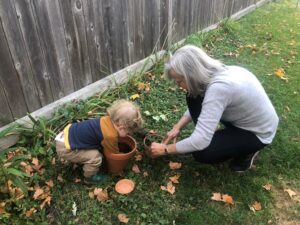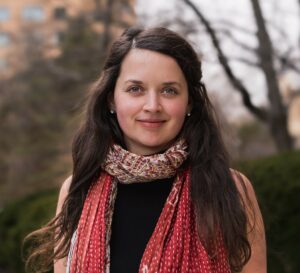When I began working with children, I was also learning how exploring movement with a sense of ease, playfulness and authentic curiosity brought me back into a state of peace and calm and ignited my neuroplasticity. I was learning how one could use language to transmit this way of moving, and this influenced my daily interactions with children, who had come into this world with these qualities of exploration fully intact. Our culture has unfortunately gone the way of often corroding these evolutionary imperatives (that, when allowed, produce an optimal flow of not just surviving, but thriving). I found it my deepest yearning to protect the authentic and sacred embodiment of these young beings’ wholeness in how I interacted with them, and I came to understand that the more I restored my own awareness and aliveness in my body, the more I could sense in my body when I was being honest and supportive with the children, or when I was passing on the hurts that have propagated in our culture, and thus diminishing, bit by bit, this sacred embodiment. Through the last twelve years as a caregiver, then teacher, and now mother, this commitment to deepen my awareness and be honest in my communication has been my compass. Every day, there are moments where I speak or otherwise communicate from a place that is inauthentic; I apologize, reframe, or simply take note for next time. Especially now as a mother, I have to find ways for daily contemplation and nourishing movement, so that I may continue to cultivate a present and centered awareness, patience, compassion, and perhaps most important, my inherent sense of playfulness. Some days and moments are easier than others to find this time and these qualities of my own aliveness, and I am learning to hold my inner and outer restoration process with compassion. Regardless of how much I am able to sink into myself, I am grateful for the intelligence that is this bodily knowing. I consider how we might speak from our whole selves. Having gone to school for theater, I spent many of my younger years learning about how to create sound from my feet up. When we have become divorced from parts of our body, when our beings are not wholly within our bodies, our voices become constricted, and we lose our ability to communicate that part of our authenticity.
I watch my toddler expressing  himself. He speaks from his feet fully in touch with the ground; from his core, ignited and full of breath; from the tips of his curious fingers. I celebrate the obligation I have been bestowed with to honor and encourage his continued embodiment and expression of such. One key practice for me is to hold space for the freedom of his emotional expression, whether it be through tears, tantrums, trembles, laughter. I hold space with a warm and loving gaze; open arms ready to hold and to keep safe him, others and belongings; and few words of my own, other than perhaps, “I’m here with you” and “I’ll keep you safe,” or “I know” and “I’m sorry” and “I can’t let you xyz”; mostly, an occasional “Mmm” of whole-hearted acceptance. We ride the waves together, trusting in this natural human animal process, this release of tensions that, left unexpressed, could create those divorces from ourselves. I make time for myself to do the same, alone or, more wonderfully, with another trusted, listening adult. This is one of the most efficient ways I have found to regain my own wholeness, especially the parts of myself that were not allowed to exist when I was young.
himself. He speaks from his feet fully in touch with the ground; from his core, ignited and full of breath; from the tips of his curious fingers. I celebrate the obligation I have been bestowed with to honor and encourage his continued embodiment and expression of such. One key practice for me is to hold space for the freedom of his emotional expression, whether it be through tears, tantrums, trembles, laughter. I hold space with a warm and loving gaze; open arms ready to hold and to keep safe him, others and belongings; and few words of my own, other than perhaps, “I’m here with you” and “I’ll keep you safe,” or “I know” and “I’m sorry” and “I can’t let you xyz”; mostly, an occasional “Mmm” of whole-hearted acceptance. We ride the waves together, trusting in this natural human animal process, this release of tensions that, left unexpressed, could create those divorces from ourselves. I make time for myself to do the same, alone or, more wonderfully, with another trusted, listening adult. This is one of the most efficient ways I have found to regain my own wholeness, especially the parts of myself that were not allowed to exist when I was young.
This leaves me feeling more hopeful and optimistic about the world, and the beauty of being human, and I make sure to infuse this into my daily interactions with young ones. I believe that optimism and honest hope is our natural state of being, and I feel my obligation to preserve this love of life in the children. Very rarely do I express any distress with or around my child, such as naming an experience, person or other being as “bad”, or something to be afraid of. If he’s in pain, I offer compassion, along with trust in his ability to heal, either out loud or inwardly. As a dear friend says, I am learning how to “bless this mess.” With this, comes embodying our honoring of all of existence in daily life, as well as in those moments of giving thanks and blessings, such as at meals. In the past month, I became aware that I was singing numbly by route our blessing songs at each meal; I had (gratefully) learned these while teaching in a Waldorf-inspired kindergarten, and I suspect that, at the time of supporting nine children in coming together for a meal and anticipating the controlled chaos that was about to ensue, I probably was more focused outside of myself while singing these songs, and that pattern had stuck around. Truly, being disembodied in moments of prayer was learned at a young age. Having grown up going to church and a religious-affiliated school where I did not find an embodied sense of the sacred, I have needed to find my way back into this prayerful and reverent presence. Plentiful time spent with the more-than-human world, simply in physical contact with trees, plants, dirt, water, stones, have been in itself a blessing back into my caring self. Creating ritual in these spaces, and in community, has been wholly expansive. With these roadmaps awakened in my body, it has been a daily joy to remember and remember and remember again, to become alive and be nourished by these practices of giving thanks and opening myself up to receive the wisdom and teachings of all the life and love that has gone into the creation of this meal in front of me. What a dream-come-true to share this with my child.

Emily Darlington Cooke is a Waldorf-inspired forest school teacher, artist and mother. She is currently devoting her time to caring for her toddler while she lays the groundwork for Milkweed Learning Community in Columbia, Missouri; she has recently begun offering an ongoing collection of stories inspired by her work and journey in motherhood on her Patreon.
Milkweed Learning Community
@MilkweedLearning
www.Patreon.com/milkweedlearning
MilkweedLearning@gmail.com